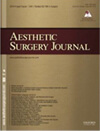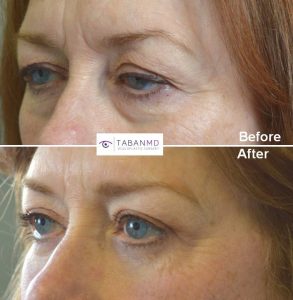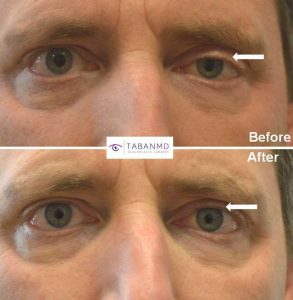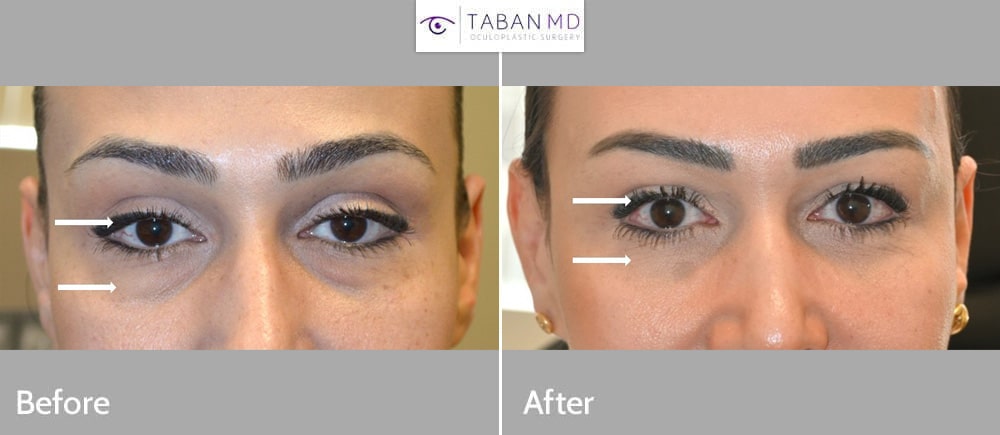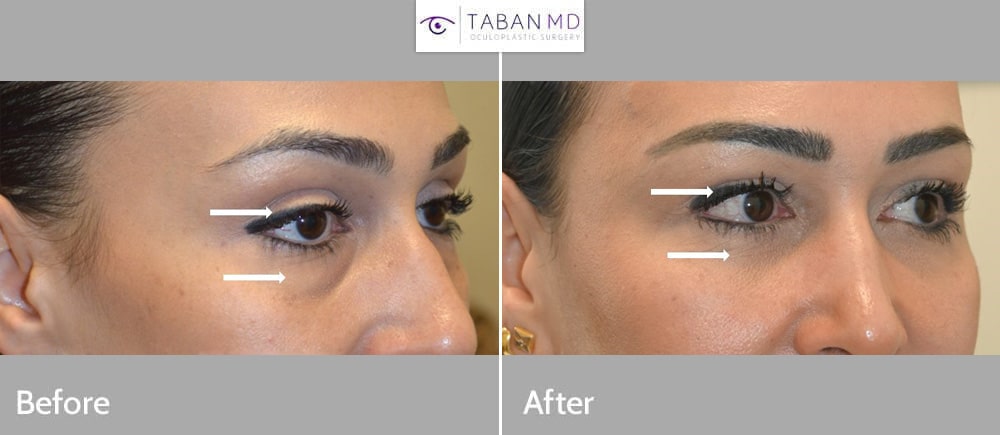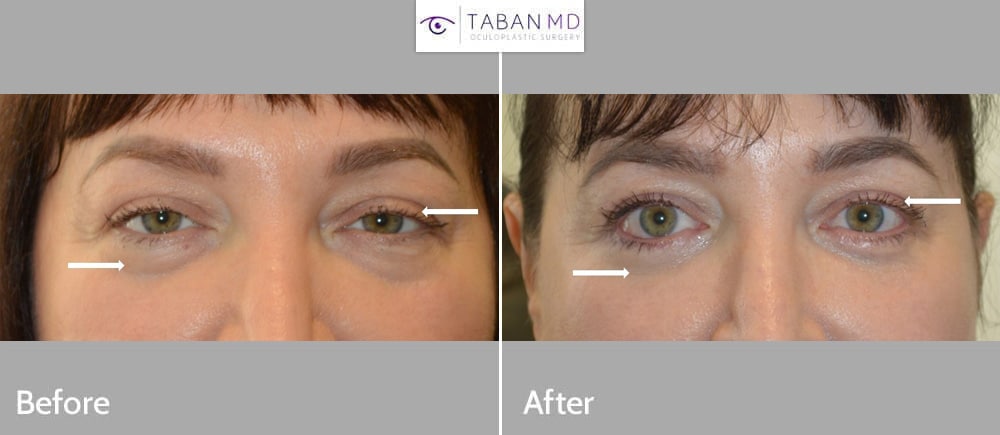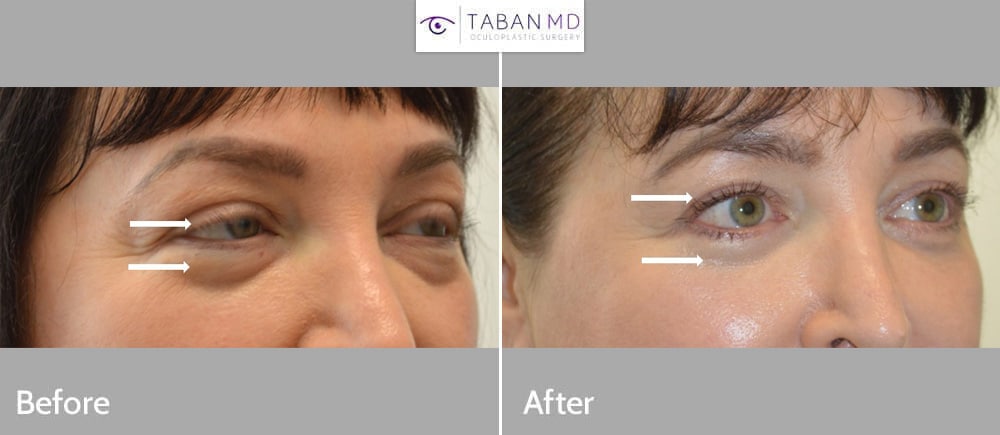Ptosis Surgery (Droopy Eyelid Surgery)
What is Droopy Eyelid (Ptosis) Surgery?
Upper eye ptosis means drooping of the upper eyelid(s). It occurs when the upper eyelid margin (where the lashes are) is lower than normal on one or both eyes. Also, it can be quite asymmetrical, making the two eyes appear to be different sizes. Droopy eyelid surgery can reduce ptosis and create an overall fresher look.
The droopiness of the upper eyelid can range from very mild to severe. If mild, it can be subtle and not noticed by the patient or others. Also, it may just be a cosmetic problem, especially if asymmetrical, causing uneven eyes and eyelid fold/crease.
Eyelid ptosis can cause the patient to look sleepy, tired, or even drunk! Fortunately, mild drooping usually does not affect your vision. Cosmetic eyelid ptosis surgery can lift the upper eyelid, creating a more symmetrical, youthful, and wakeful eye appearance.
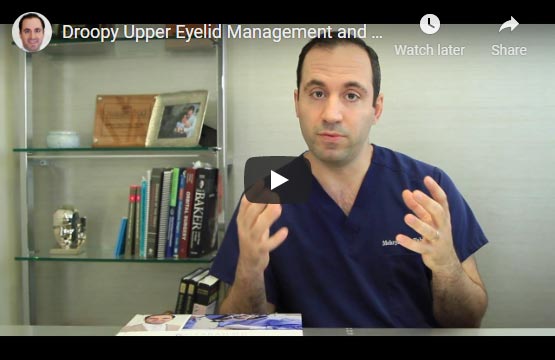

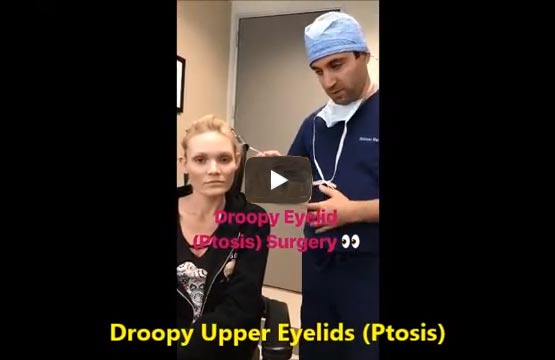
If the droopy eyelid is severe, it can obstruct the field of vision. In these cases, the patient may have difficulty keeping their eyes open. They may even need to elevate or arch their eyebrow to assist in lifting the upper eye fold. This visual obstruction can be relieved when the upper eyelids are lifted. That is the goal of eyelid ptosis surgery or droopy eyelid surgery.
It is important to note that children with this condition may develop lazy eye and even permanent vision loss if not addressed promptly.
What Causes Droopy Upper Eyelid?
There are various causes of upper eyelid droopiness, including:
- Congenital or inherited (born with it)
- Traumatic injuries
- Neurologic conditions
- Age-related loosening/weakening of the levator muscle tendon (responsible for lifting the upper eyelids)
This last item is the most common cause. The levator muscle lifts the upper eyelids about 20,000 times per day, every day! One can imagine that the tendon attachment can get loose, which causes the upper eye fold to drop. This weakening of the levator muscle or tendon can be worsened by previous eye surgery due to stretching the muscle or tendon. Wearing contact lenses long-term can also affect the muscle and cause the upper eyelid to droop.
What Is NOT Ptosis?
The most important factor to consider in evaluating true eyelid ptosis is to rule out other causes of pseudo-ptosis. We want to ensure it is not dermatochalasis (excess puffy upper eye fold skin/fat) or droopy eyebrows.
As mentioned earlier, the position of the upper eyelid is determined by the levator muscle/tendon. Excess or puffy upper eye fold skin will NOT change the height but can give the illusion of it. The treatment for this would be upper eyelid surgery. In this procedure, excess skin and fat are removed from the upper eye folds.
Droopy eyebrows can also cause heaviness of the upper eyelids. They commonly also give the appearance of hooded, saggy, droopy upper eyelids. However, the treatment for this would be brow lifting. Many patients have a combination of the three factors that contribute to “droopy” upper eye folds. That means they may have:
- Ptosis
- Dermatochalasis
- And droopy eyebrows
Such cases may require a combination of three separate surgeries.
How Is Upper Eyelid Ptosis Corrected?
Upper eyelid ptosis surgery is the proper droopy eyelid surgery. It works by surgically tightening the levator muscles to raise the droopy upper eyelids. Dr. Taban uses various available techniques to tighten the levator muscle, also known as a levator resection. The chosen method depends on the:
- Type and severity of the ptosis
- Strength of the levator muscle
- Previous cosmetic eyelid surgery
Eyelid ptosis repair can be performed with incisions behind the upper eyelid. This method results in scar-less treatment with an excellent eyelid contour. This correction could also be performed from the front skin approach (external ptosis surgery). This approach hides the incision in the upper eye fold crease line. Such an incision is the same as in standard upper blepharoplasty.
In congenital ptosis, the upper eyelid has to be linked to the forehead muscle (frontalis muscle). This step allows use of the forehead muscle to lift the droopy upper eyelids. This technique is called frontalis sling.
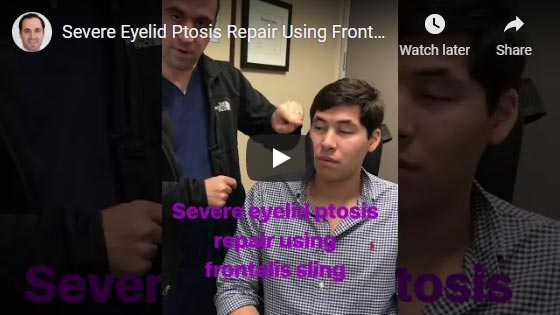
Video of young man who came from Ecuador to have frontalis sling surgery for severe congenital droopy upper eyelids (ptosis).
Is Ptosis Repair Right for Me?
The term “droopy” upper eyelid is often used loosely. This can mean true droopy upper eyelid, or other eyelid and brow conditions that look similar. Similarly, the term “eyelid or lid lift” is often used incorrectly or broadly. Some use it to mean either an:
- Eyelid ptosis treatment (levator tightening to raise the upper eyelid)
- Upper blepharoplasty (removing excess skin/fat)
- Eyebrow lift
- Or a combination of these
However, each of these has its differences. So, it is crucial for the eyelid specialist to evaluate the patient’s anatomy. The goal is to determine which of these factors are involved and discuss the best comprehensive treatment. If more than one problem is present, each issue can and should be addressed. This is best done together so that the patient doesn’t have to go through multiple operations at different times.
To understand your options for droopy eyelid treatment, contact us today. You can meet with expert surgeon Dr. Taban one-on-one for your initial consultation in our offices. We are located in the greater Los Angeles area, including Beverly Hills and Santa Barbara.

Procedure Overview
Eyelid ptosis treatment surgery is easily performed under local anesthesia. Still, you may have oral sedation or local anesthesia with IV sedation to improve comfort. First, the patient’s eyelid is numbed using local anesthesia while the patient is relaxed. During the procedure, the patient can open and close the eye fold. This helps achieve the best eyelid contour and eye symmetry.
Revisional Surgery
Beverly Hills cosmetic eyelid surgeon Dr. Taban is also an expert in revision eyelid ptosis surgery. If you had a previous surgery that did not deliver the results you wanted, then this might be for you.
Dr. Taban uses a special technique that takes advantage of existing scar tissue in the eyelids. He has presented on this topic nationally and internationally. Above all, he has treated patients from around the world who have had up to three failed ptosis repairs, with great success. Please visit our Revision Ptosis Surgery page for more details.
Read an Article by Los Angeles’ Dr. Taban about his Utilitarian Upper Eyelid Operation techniques.
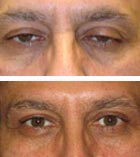
Recovery After Ptosis Surgery
The recovery process after eyelid ptosis surgery is generally quite light. Most patients report only minimal discomfort that is easily managed. Still, bruising /swelling of the eyelids for about 7-10 days afterward is normal. However, your vision remains intact during this time since no patch is needed! The sutures are taken out about one week after surgery (although absorbable stitches can also be used). Once your stitches are you, you can resume normal activities.
If you have any questions during your recovery, give us a call and we will gladly help you. Dr. Taban and his team are with you every step of the way.
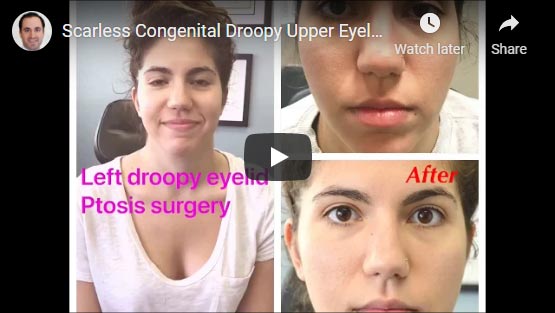
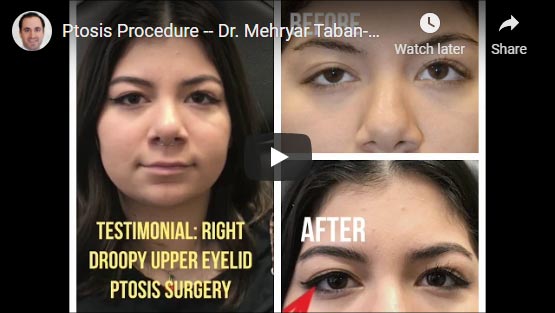
Who Should Perform Droopy Eyelid Repair?
Eye fold corrective surgery should be performed by an oculoplastic surgeon who is:
- A member of the American Society of Ophthalmic Plastic and Reconstructive Surgery (ASOPRS).
- A board-certified ophthalmologist. Specifically, one who has completed an additional two-year fellowship training in cosmetic and reconstructive eye plastic surgery.
Dr. Taban in Beverly Hills has a complete set of certifications and intensive experience. He is double board-certified by:
- The American Society of Ophthalmic Plastic and Reconstructive Surgery (ASOPRS)
- The American Board of Ophthalmology (ABO/AAO)
Additionally, he is a diplomat of the American Board of Cosmetic Surgery (ABCS). Dr. Taban is an oculoplastic surgeon with expertise in eye fold ptosis surgery and revisional eyelid ptosis surgery.
Schedule Your Consultation
Call us today to schedule your consultation for ptosis repair surgery. From start to finish, Dr. Taban and his expert team are by your side. Contact us to learn more about our treatment options and get started on enhancing your appearance. We look forward to working with you soon.
Before & After Photos
After doing research and reviewing multiple doctors online I came across Dr Taban. After having a consultation with him in regards to a ptosis issue and cosmetic issues , I knew immediately that he would be the doctor for me. … He is a highly competent physician … The surgery and recovery went well …I wouldn’t hesitate to recommend Dr Taban to anyone who is questioning whether or not to get surgery since he will answer all of your questions and will reassure you. The results are great and I would recommend him to anyone!
Dr Taban Is an extremely skilled & talented doctor. He corrected my ptosis in one eye perfectly. I was previously told by another highly rated doctor that he wouldn’t try to fix it because it was too mild and was concerned about over correcting. I am so happy I found Dr Taban. My eyes are now perfect! I highly recommended him.
… I not only needed upper and lower eyelifts but also surgery to repair ptosis or droopy upper eyelids… During my initial consultation Dr. Taban fully explained the surgery to me and answered all my questions. … It is more than one month after my surgery now and the results are amazing… Dr. Taban is truly a miracle worker… THANK YOU Dr. Taban for the incredible job you did on my eye surgery!!! YOU’RE THE BEST!!!!!
Dr. Taban and his staff are amazing! I went into his office for ptosis (droopy eyelid) … This office goes above and beyond most other doctors … They make you feel very comfortable … I highly recommend Dr. Taban and his whole crew!

